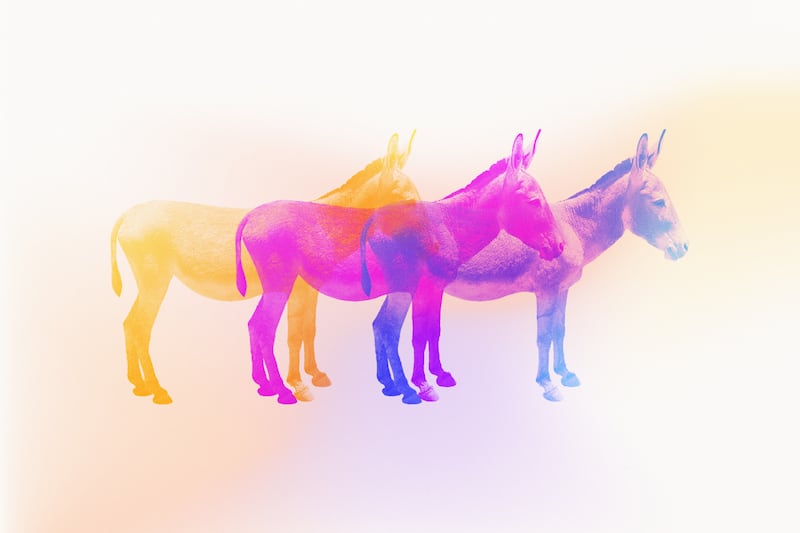Over the past two decades, the share of Americans who identify as a Democrat has been remarkably stable, hovering within a few percentage points of 33%. But the traits of the actual people who account for that statistic have shifted dramatically, making the party more diverse, more liberal and far less religious, according to a new report from the Survey Center on American Life.
“The stable size of Democratic Party membership among the public belies large changes in its composition,” wrote Daniel Cox, the center’s director, in his analysis of the trends.
The report digs into a number of those changes, exploring how rising racial diversity and educational attainment, for example, have influenced the Democratic Party’s policy goals. Taken together, the various shifts have clearly complicated the work of leaders like President Joe Biden, Cox wrote.
“Party leaders are forced to negotiate among competing groups with distinct experiences and preferences, making it more difficult for the party to develop a coherent identity and a governing agenda that appeals to the varying factional interests,” he said.
Here’s a look at how the Democratic Party has transformed since the turn of the 21st century, and at what the various demographic shifts could mean for the future:
The Democratic Party is more racially and ethnically diverse.
In 1998, 7 in 10 Democrats identified as white and non-Hispanic. Today, that figure sits at 56%.
The party has clearly become more diverse, but changes to its racial and ethnic composition weren’t as gradual as you might assume, Cox wrote, noting that much of the shift took place during former President Barack Obama’s time in the White House.
“The proportion of Hispanics increased dramatically during the Obama years, rising from 8% in 2009 to 18% in 2016,” according to the report. “Conversely, the white population of the Democratic Party cratered during Obama’s presidency.”
Regardless of when it happened, it’s clear that the diversification of the party has affected its platform. Democratic leaders are putting more energy behind solving issues like racism today than they did in the past, Cox wrote.
“The growing racial and ethnic diversity in the Democratic Party has likely contributed to the party’s commitment to pluralism, spurring a more concerted pro-immigration platform and an emphasis on racial inequality,” he said.
The Democratic Party is more liberal.
Another demographic shift driving changes to the party’s priorities is the rising share of Democrats who identify as liberal (as opposed to moderate or conservative). Since the late 1990s, the percentage of Democrats who describe themselves as liberal has nearly doubled, from 28% to 50%, the report said.
“Liberals now outnumber conservatives in the Democratic Party by more than four to one,” Cox wrote.
The growing group of liberals has different policy goals than other Democrats, which helps explain why party members increasingly seem engaged in a war against each other. Democratic officials clash over whether the party “should concentrate on promoting policies with widespread public appeal ... or a robust progressive agenda,” Cox wrote.
The Democratic Party is less religious.
In the past 20 years, the country as a whole has become less religious. Even against this backdrop, the surge in nonreligious Democrats stands out.
“Democratic religious membership has fallen further than among Republicans, more than doubling the partisan gap in religious membership,” the report said. It noted that fewer than half of Democrats today “report being a member of a church.”
Perhaps unsurprisingly, the share of party members who say religion is important to them personally is also falling. In 1998, around two-thirds of Democrats espoused that view. Just over two decades later, only 43% of Democrats say the same.
In the report, Cox argued that these faith-related shifts will be felt — and, in some ways, are already being felt — by the whole country and especially by those engaged in religious freedom debates.
“The growing number of Democrats who are not religious members will invariably influence the party’s approach to public expressions of religion and the role of faith in public life,” the survey said.
And just as the growing group of liberal Democrats complicates party leaders’ efforts to pass moderate policies, the growing group of secular Democrats complicates leaders’ efforts to appeal to religious voters.
“There are Christians who would like to vote for Democrats and don’t want to feel like Democrats are sneering at them for their stupid, old-fashioned religiosity,” said Stephen Prothero, a religion professor at Boston University, to the Deseret News in 2019 after the Democratic Party faced pushback for praising nonreligious voters.
The Democratic Party has more unmarried, childless adults.
Moving forward, Democrats could also grow less interested in crafting or supporting policies that encourage marriage among partnered adults. The share of party members who has never been married has grown by nine percentage points in the past two decades, according to the report.
“Most Americans believe society is better off if couples who want to stay together long term decide to get married, but only 40% of Democrats agree,” Cox wrote.
He also pointed out that Democrats today are less likely to have children than Democrats in the past. Around one-quarter of today’s Democrats are parents, compared to 35% of party members in 1998.


